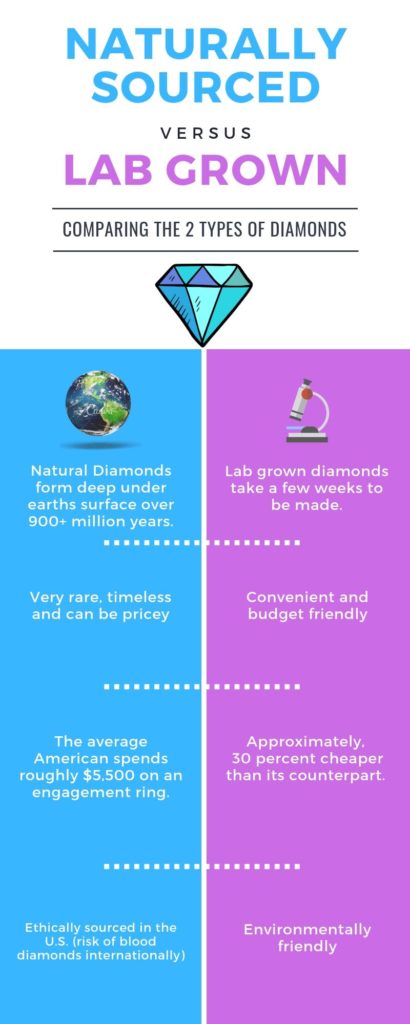Rumored Buzz on Lab Grown Diamonds
Table of ContentsSome Known Facts About Lab Grown Diamonds.Lab Grown Diamonds - The FactsOur Lab Grown Diamonds StatementsThe Buzz on Lab Grown DiamondsLab Grown Diamonds Can Be Fun For Everyone
Typical ruby mining can have hazardous results on the setting and often involves unethical labor practices. In contrast, lab-grown diamonds are created in controlled environments making use of innovative technology. They leave a smaller carbon footprint and are devoid of the moral worries usually associated with the ruby market. Lab-grown rubies use you a possibility to conserve significantly on your interaction ring spending plan without endangering quality.What are lab-grown rubies? How do they contrast to all-natural rubies, and are they worth it? We've been hearing more concerns like these recently. At Miriam's Precious jewelry, we'll always keep you aware. As your favored household jeweler, we're here to aid you make the finest decisions when acquiring precious jewelry you'll treasure for a life time.
They are extra affordable, yet their value likely will not hold up in time. They will certainly also never ever have the exact same rarity, originality and definition as a natural rock that was formed over billions of years deep in the earth. That stated, we're everything about options at Miriam's, and we always put customers first.
Lab-created diamonds, also called manufactured diamonds, are expanded in a laboratory. They are the same to all-natural rubies in every way, including the way they shimmer and their sturdiness. You can not inform the difference by looking. They have the exact same chemical and physical buildings as diamonds located in the earth, and are thought about the very same gems under the Federal Profession Compensation (FTC).
The Of Lab Grown Diamonds
The procedure imitates the all-natural development of standard, extracted rubies, which are developed deep in the earth's crust, under conditions of warmth and pressure. A ruby's natural process takes billions of years to form. On the other hand, diamonds developed in a laboratory take only an issue of weeks to form.
Among the leading reasons to acquire lab-created diamonds is that they are much more economical. Male made diamonds can set you back approximately 30 to 40 percent much less than all-natural rubies of the exact same size and top quality. That's because the procedure of mining natural rubies is lengthy, tough, and expensive. Rubies from a laboratory merely cost much less to make.
There are possibly less ecological impacts since they are not extracted from the planet, and they may be safer to make. However, lab-made diamonds still utilize bunches of power and take substantial factories go to generate, so they might not be as environmentally-friendly as we think. You may intend to trade-in or trade-up a lab-made ruby in a few years, just to locate it's worth dimes on what you paid for.
Excitement About Lab Grown Diamonds
The higher the supply, the much less valuable the product. You might pay much less to get your ruby currently, yet you likely won't obtain much, if anything, back from it later. Natural diamonds are more of an investment because they will certainly constantly be an unusual commodity. Given that they took billions of years to create, there will just be so numerous natural diamonds readily available in our life time.
, wedding celebrations, and wedding anniversaries. try these out When picking a diamond, you desire the best you can manage.
Whatever they are called, a lab-grown diamond, real to its name, is produced in a laboratory. Stress High-Heat approach, and the various other is the Chemical Vapor Deposition technique. The High-Pressure High-Heat method is a simulation of the problems that lead to the formation of natural diamonds in the midsts of the planet.
How Lab Grown Diamonds can Save You Time, Stress, and Money.
Critical between natural diamonds and lab-created ones is difficult for the ordinary individual. A ruby simulant is a stone that imitates a diamond, but it doesn't have just the same homes as a diamond. Cubic zirconia is one example of a cost-effective ruby simulant. Moissanite is one more instance of a ruby simulant.

Nonetheless, neither official site of these rocks is the same as a lab-created ruby. Lab-created rubies are made from carbon like natural diamonds are. A lab-grown ruby's atomic makeup coincides as that of a natural diamond. These are actual diamonds, not simulants. Lab-grown rubies have the exact same make-up as natural rubies.
The damage to ecosystems and watersheds expands well past the opening where the diamond mine lies. Between damage to natural environments and using fossil fuels for running tools, diamond mines are not eco-friendly. Lab-grown rubies, however, can be expanded utilizing renewable energies to power the centers.
Lab Grown Diamonds Things To Know Before You Buy
This is another factor to think about a lab-grown ruby. They are around 40% more affordable than their mined counterparts. This suggests you can obtain a bigger lab-created rock for the exact same cash. Or, you could choose a custom-made setup or much better steel than you believed you would have the ability to acquire Individuals worth understanding where their gems come from.
